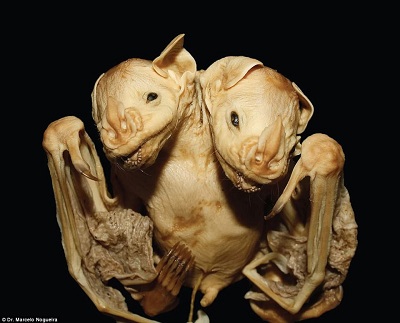Researchers have discovered the third case ever of a pair of conjoined bats in southeastern Brazil.
The newborn bat twins’ corpse is conjoined at the torso, with its two heads side by side according to Daily mail.
While researchers aren’t sure what causes identical twins to be conjoined, it can occur when a fertilized egg splits too late.
The study found that the bat twins were male large fruit-eating bats of the genus Artibeus.
The specimen was found with the umbilical cord and placenta still attached, indicating that the twins were newborn.
The twins have separated heads and necks but a conjoined trunk with an abnormally expanded thorax, with ultrasound analysis revealing that they have two similarly sized and separate hearts.
X-ray analysis of the bat corpse revealed two separate vertebral columns that fuse at the lower part of the back.
Dr Marcelo Rodrigues Nogueira, a postdoctoral researcher in biology and the lead author of the research, said that the twins were ‘completely unexpected.’
‘Bats are impressively diverse in their shapes and colors, and as a result of our extensive effort to sample these mammals in several biomes we have seen many amazing species.
‘These twins, however, were completely unexpected.
‘They belong to a very common bat genus (Artibeus), but their condition makes them unique and really staggering.’
Dr Nogueira also says that the team has no immediate plans to conduct further studies with the specimen.
The only other two cases of conjoined bats were observed in 1969 and 2015.
Dr Daniel Urban, a researcher who was not involved with the study, said that most bats have only one pup per litter, so even finding nonconjoined bat twins is rare.
And Dr Scott Pedersen, a researcher who was also not involved with the study, says that the fact that bats are nocturnal make the findings even more rare.
If a mother had given birth to the conjoined bats during the day, it would have likely been in a protected area such as a roost.
Giving birth out in the open would usually only happen at night, so the fact that the specimen was found underneath a mango tree is surprising.
When the researchers analyzed the specimen, they saw that it had a noticeable volume in the middle upper back and between the heads, which looked like a rudimentary forelimb, with the end of the structure resembling a thumb.
However, the only bones identified in the area showed no evidence of being finger or arm bones.
According to the researchers, because no invasive methods were used to analyze the corpse, the only information available about its internal organs are those on heart number and size.
The bat specimen is what is known dicephalic parapagus conjoined twins.
Dicephalic is a medical term meaning ‘union of the entire trunk but not heads’ and parapagus means ‘laterally united’.
Mortality rates for conjoined twins are very high, reaching close to 80 per cent of deaths within a day after birth.
But cases of conjoined twins have also been observed in domestic and lab animals, but reported cases of conjoined twins in the wild is scarce – in a survey from 1671 to 2006, only 19 records to which two or more could have been added, were found.
N.H.Kh

